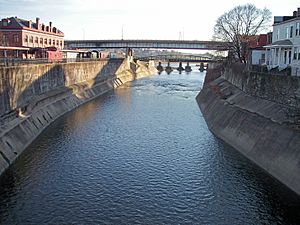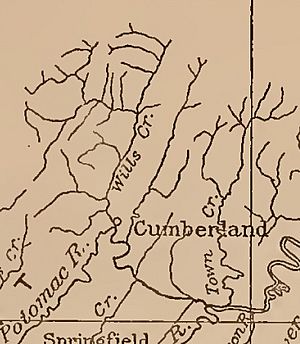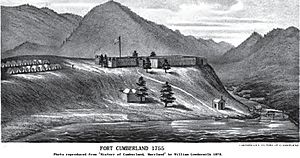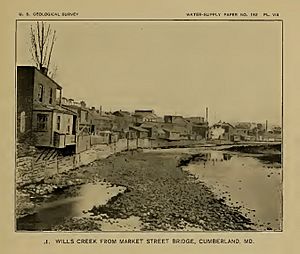Wills Creek (North Branch Potomac River tributary) facts for kids

Wills Creek is a stream about 38.6 miles (62.1 km) long. It flows into the North Branch Potomac River. You can find Wills Creek in both Pennsylvania and Maryland in the United States.
Contents
Where Does Wills Creek Flow?
Wills Creek starts high up in the Allegheny Mountains. This is in southeastern Somerset County, Pennsylvania. It begins on the western side of Savage Mountain.
The creek flows through several towns in Pennsylvania. These include Mance, Philson Station, and Glencoe. It also passes through Foley, Fairhope, and Williams Station. Then, Wills Creek enters Bedford County, Pennsylvania. It flows through Hyndman and turns sharply south.
Finally, Wills Creek crosses from Pennsylvania into Maryland. It enters Allegany County, Maryland near Ellerslie. From there, it flows past Corriganville and near Narrows Park. The creek then joins the North Branch Potomac River in Cumberland, Maryland.
Smaller Streams Joining Wills Creek
Many smaller streams, called tributaries, flow into Wills Creek. In its early sections, you'll find Laurel Run, Mountain Run, Brush Creek, Shaffers Run, and Gooseberry Run.
A larger stream called Little Wills Creek joins Wills Creek at Hyndman. As Wills Creek flows south, Thompson Run and Gladdens Run add their water. Jennings Run joins at Corriganville. Finally, Braddock Run flows into Wills Creek near Narrows Park.
- Brush Creek (Wills Creek)
- Little Wills Creek
The History of Wills Creek's Name
Wills Creek got its name from a place called Will's Town. This was a settlement of the Shawnee Native Americans. It was located where Cumberland, Maryland, is today.
After the Shawnee left the area, a Native American named Will lived there. He had a cabin on the side of the mountain. The creek, the mountain, and later the town were all named after him. Maps from the 1750s already showed "Will's creek."
In the early 1900s, Wills Creek faced a big problem. Factories and homes in Cumberland often dumped their waste directly into the creek. This caused a lot of pollution.
Protecting Cumberland from Floods
Cumberland had serious floods from Wills Creek in the past. Big floods happened in 1924, 1936, and 1942. These floods caused a lot of damage to the city.
To stop this, the city of Cumberland worked with the United States Army Corps of Engineers. In the 1950s, they started a huge project. It cost $18.5 million, which was a lot of money back then!
They built a special flood-control system. They paved the bottom of Wills Creek with concrete. They also built strong concrete walls along its banks. A smart pumping system was added to prevent flooding during heavy rains. This big project took ten years to finish, ending in 1959. Since then, the system has successfully kept Cumberland safe from floods.




